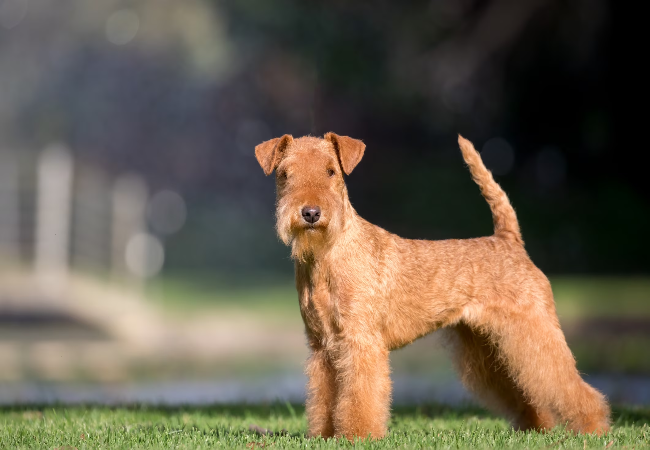Lakeland Terrier 2025: Energetic Lake District Terrier Health & Care 🐶✨

In this article
Lakeland Terrier 2025: Energetic Lake District Terrier Health & Care 🐶✨
By Dr. Duncan Houston BVSc
Introduction 🌟
The Lakeland Terrier is a small but bold terrier hailing from England’s Lake District—originally bred in the 1700s to hunt vermin and foxes. With a wiry, low-shedding coat and a spirited personality, this breed thrives in active households that appreciate its energy and tenacity. This 2025 guide provides comprehensive advice on temperament, grooming, health, training, and lifestyle fit.
1. History & Origins 📜
- Named for the Lake District in northern England, where it was used by farmers to hunt predators like foxes and badgers.
- Descends from Fell and Black-and-Tan terriers, with later crosses to Fox and Airedale terriers.
- Recognized by the AKC in 1934, retained traditional working traits alongside show recognition.
2. Physical Appearance & Coat 🧥
- Height: ~13.5–15 in; Weight: ~15–17 lb.
- Square build with narrow chest, V-shaped ears, bushy brows, and upright tail.
- Dense double coat: harsh, wiry outer layer over soft undercoat; minimal shedding when hand-stripped.
- Colors include wheaten, red, black-and-tan, blue, liver, and grizzle/tan combinations.
3. Temperament & Personality ❤️
- Intelligent, confident, bold, and vocal when prompted.
- Friendly with familiar people and children—but early socialization helps temper any wary instincts.
- Strong prey drive; may dig and chase unless supervised.
- Can be independent or stubborn; positive, consistent training is key.
- Prone to separation anxiety or boredom if left idle.
4. Exercise & Mental Stimulation 🏃♂️
- Need at least 1 hour of daily exercise: walks, play, digging areas.
- Thrives in dog sports like agility, tracking, Earthdog trials.
- Puzzle feeders and scent games also provide essential mental enrichment.
5. Grooming & Coat Maintenance ✂️
- Brush weekly; hand-strip dead hair several times per year to maintain texture.
- Bathe every 4–6 weeks or as needed; avoid over-bathing to preserve coat oils.
- Trim beard, pluck ear hair, clean ears and teeth, and clip nails regularly.
- Hand-stripping near eyebrows and legs enhances the show coat and functionality.
6. Health & Lifespan 🩺
Generally healthy, with an average lifespan of 12–15 years.
6.1 Common Health Issues:
- Dental disease (tartar, gum inflammation)—regular brushing and annual dental checks are necessary.
- Patellar luxation—kneecap dislocation; monitor for lameness; X-rays help diagnose.
- Dermatomyositis—rare skin/muscle inflammation documented.
- Eye conditions like cataracts or glaucoma—screening is helpful.
- Ear infections if hygiene is neglected.
6.2 Recommended Health Care:
- Annual vet exams, dental cleanings, and weight checks.
- aX-ray screening for patella; optionally hip/elbow evaluation.
- Eye exams (CERF/CAER) every couple of years.
- Maintain routine parasite prevention and vaccinations.
7. Nutrition & Feeding 🍽️
- Balanced, AAFCO-compliant diet for small-to-medium breeds; puppy stage might need 3–4 small meals for blood sugar stability.
- Adult feeding: twice daily measured meals; puzzles enrich mealtime and prevent overeating.
- Weight control to prevent joint strain; occasional omega-3 for coat health.
- Dental chews can support oral hygiene.
8. Training & Socializing 🎓
- Start socialization early—introduce diverse stimuli, people, and pets.
- Use reward-based, consistent training to foster cooperation.
- Crate training helps provide structure and reduce anxiety.
- Teach recall firmly to combat hunting instincts.
9. Family Suitability & Lifestyle 🏡
- Good with families and older children; supervision needed with young kids due to terrier energy.
- Not ideal for apartment living without adequate exercise.
- Digging and barking can be managed with secure yards and training.
- Low shedding makes them relatively allergy-friendly but not hypoallergenic.
10. Adoption vs. Breeder Advice 🌟
- Rescue Lakelands often need active homes—ask local breed rescues.
- Reputable breeders provide health clearances, temperament-tested pups.
- Expect prices around $1,200–2,400; ask about coat care guidance.
11. FAQs ❓
- Do they shed? Minimal with proper grooming and hand-stripping.
- Are they good with cats? May chase small animals unless raised together.
- Are they apartment-friendly? Only if mentally and physically stimulated.
- Do they bark a lot? Alert barkers; training can help moderate noise.
12. Ask A Vet, 🐾
- Ask A Vet: Quick expert advice for dental care, lameness, skin/ear issues, or anxiety questions.
13. Final Recommendations ✅
The Lakeland Terrier is a bold, intelligent companion with a wiry coat and energetic disposition—perfect for active owners who value traditional terrier traits. Proper grooming, structured training, and plenty of exercise will bring out the best in this breed. Visit AskAVet.com and download the Ask A Vet app for ongoing veterinary support and care advice.






